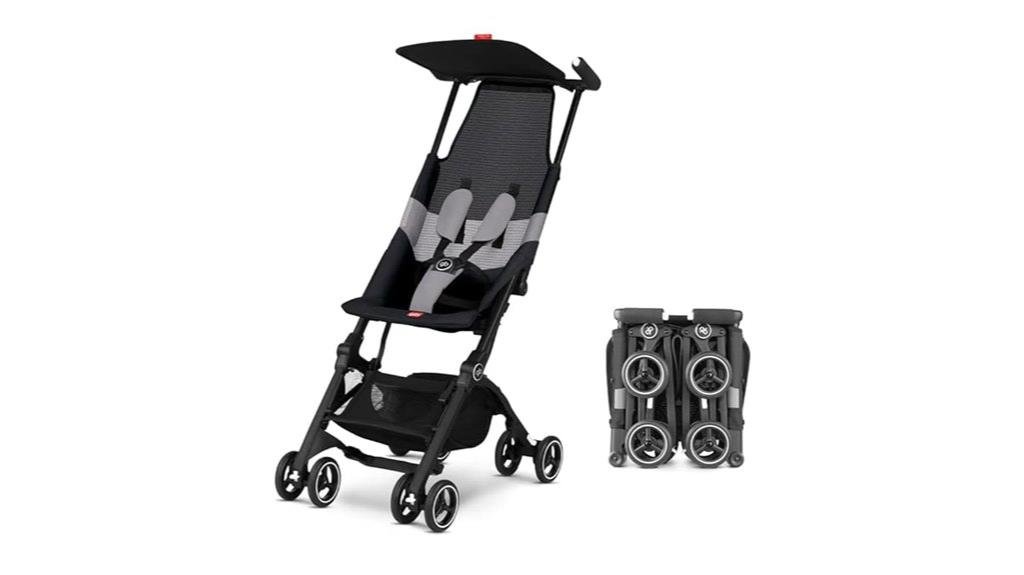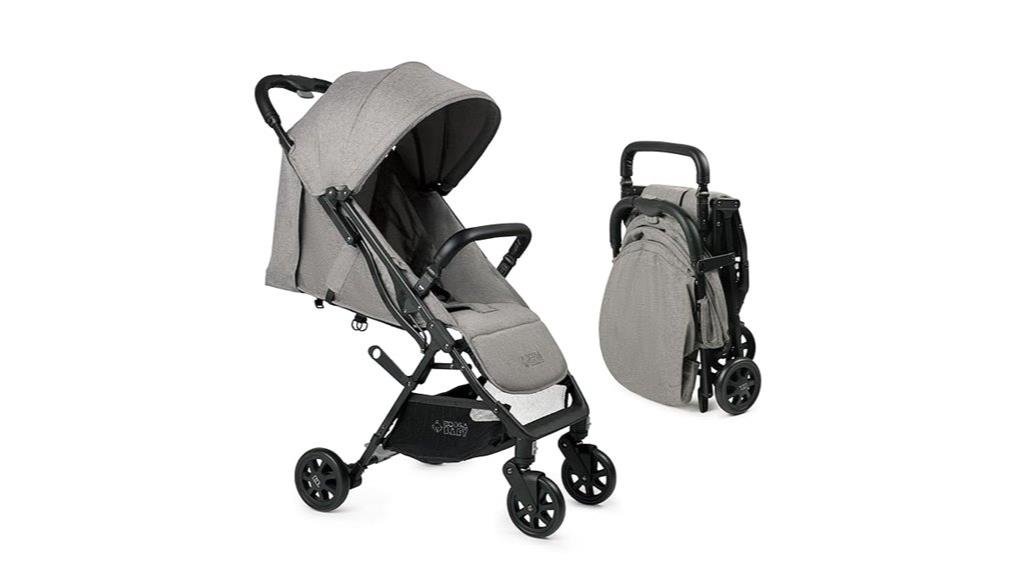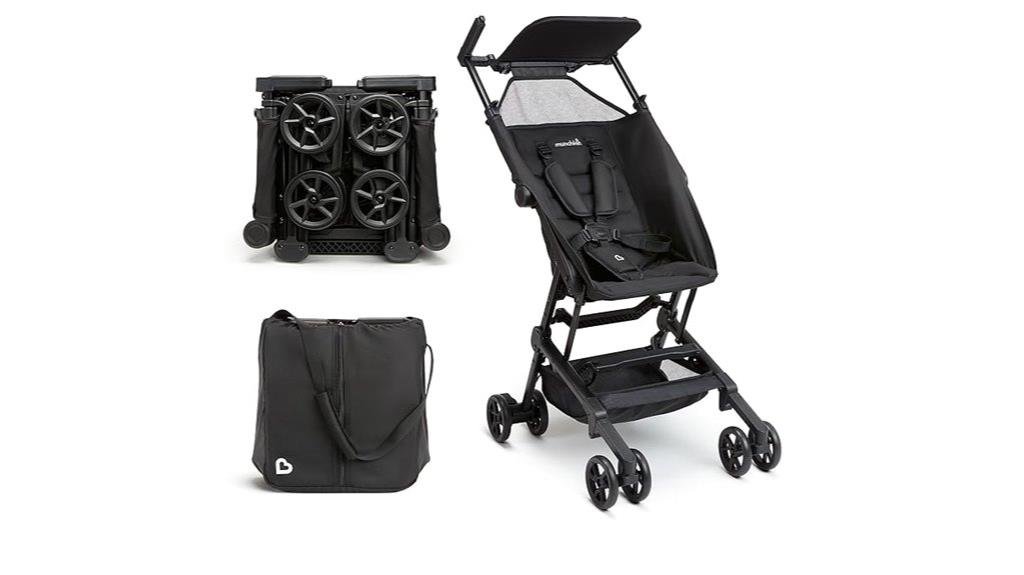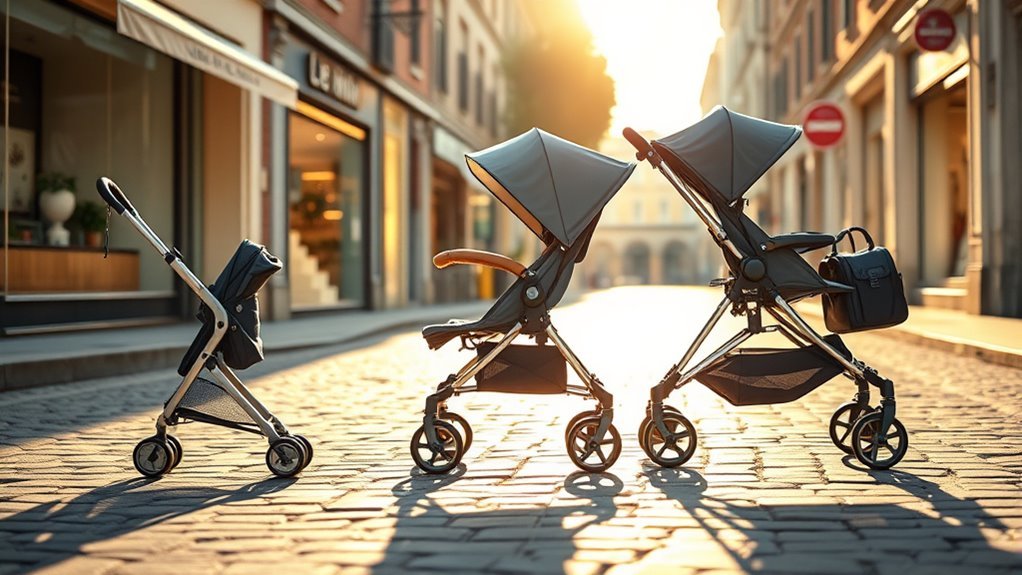We’ve tested compact strollers so you can travel light and move through tight spaces with confidence. Each pick balances portability, comfort, and safety, and we’ll explain what makes them stand out for different trips and kids. Keep going to see which model fits your needs and luggage limits.
gb Pockit Air All Terrain Ultra Compact Lightweight Travel Stroller (Velvet Black)

If you need an ultra-compact stroller for frequent travel and tight storage, the gb Pockit Air All Terrain is a standout: it folds down to a handbag-sized 11.8 x 7 x 13.8 inches, weighs just 10.4 lb (4.6 kg) and meets airplane hand-luggage dimensions, so you can lift it into overhead bins and move through crowded transit with minimal fuss. You’ll appreciate its breathable mesh backrest for hot days and optional padded inlay for chillier outings. Double wheels handle varied surfaces, aluminum frame keeps weight low, and a three-point harness secures one child up to 55 lb. Care’s simple: spot or wipe clean.
Best For: Travelers and city parents who need an ultra-compact, lightweight stroller that fits overhead airplane bins and tight storage spaces.
Pros:
- Extremely compact fold (11.8 x 7 x 13.8 in) and airplane hand-luggage compliant for easy travel and storage.
- Lightweight aluminum frame (4.6 lb frame; 10.4 lb total) makes lifting and maneuvering simple.
- Breathable mesh backrest plus optional padded inlay provides comfort across different weather conditions.
Cons:
- Not compatible with car seats, limiting use for newborns or travel systems.
- No built-in brake system or integrated lights, reducing convenience and safety features.
- Plastic/EVA wheels and a 3-point harness may feel less robust compared with heavier all-terrain strollers.
Lightweight Travel Stroller for Baby and Toddlers (Grey)

Lightweight and compact, the KOOLABABY YD209 is ideal for parents who travel often and need a stroller that fits in plane overhead bins and small trunks. You’ll appreciate its 14-pound aluminum frame, one-hand fold, and convenient carry handle for quick changes. It suits babies and toddlers 6–36 months with a 33-pound max, multiple recline positions, an extendable 80/20 cotton-rayon canopy, and a 5-point harness plus safety bar and foot brake for security. Rubber tires and four-wheel maneuverability make steering easy, while the spacious basket stores essentials. Wipe-clean polyester keeps maintenance simple. Reviews average 4.3/5 from 312 ratings.
Best For: Parents and frequent travelers needing a lightweight, compact stroller that fits overhead bins and small trunks while offering basic safety and comfort for babies 6–36 months.
Pros:
- Lightweight 14-pound aluminum frame with one-hand fold and carry handle for easy travel and storage.
- Multiple recline positions, extendable 80/20 cotton-rayon canopy, and 5-point harness for comfort and security.
- Compact footprint with four-wheel maneuverability and a spacious storage basket for essentials.
Cons:
- Maximum weight recommendation of 33 pounds limits use for larger toddlers.
- Basic wipe-clean polyester fabric and minimal warranty (Amazon 30-day return policy) may concern long-term durability.
- Not intended for heavy off-road use—rubber tires and lightweight design prioritize portability over rugged terrain handling.
Munchkin Sparrow Travel Baby Stroller (Ultra Compact, Lightweight)

Traveling parents will appreciate the Munchkin Sparrow for its ultra-compact fold that fits in most overhead bins, making it a top choice for frequent flyers and on-the-go families. You’ll like its 12.8 lb aluminum frame and breathable mesh fabric that keeps your child comfortable up to 55 lbs and 41 inches. The intuitive forward fold, included carrying case, and easy-zip bag simplify transport and storage. It has a 5-point harness, mesh headrest, sun shade, rubber tires, and a handy storage basket. No assembly’s required; wipe-clean care keeps maintenance simple. Rated 4.5/5 from nearly 700 reviews.
Best For: Traveling parents and frequent flyers who need an ultra-compact, lightweight stroller that fits overhead bins and is easy to transport.
Pros:
- Extremely compact and lightweight (12.8 lb) with a forward fold and included carrying case for effortless travel.
- Breathable mesh fabric, 5-point harness, sun shade, and mesh headrest for child comfort and safety up to 55 lbs.
- No assembly required, wipe-clean care, and rubber tires plus a storage basket for everyday convenience.
Cons:
- Limited to children who can sit upright unassisted and under the height/weight limits (41 in / 55 lbs).
- Mesh fabric may offer less padding and weather protection compared with fuller fabric strollers.
- Not suitable for rough terrain or heavy-duty use due to lightweight frame and small travel-oriented tires.
Factors to Consider When Choosing a Small Stroller for Travel
As we compare small travel strollers, we’ll focus on the practical factors that matter most: weight and portability, folded size and how it fits in our trunk or overhead bin, and carrying convenience. We’ll also check weight capacity limits to make sure the stroller suits our child as they grow and evaluate safety restraints for secure rides. Keeping these points front and center helps us pick a compact stroller that’s truly travel-ready.
Weight and Portability
When we’re picking a small stroller for trips, we want one that’s easy to lift, carry, and stow without slowing us down. Weight matters: a lightweight model around 10–14 pounds makes hauling through airports, up flights, or into taxis far less tiring. Portability features add real value — built-in carry handles, travel bags, or shoulder straps let us move hands-free between transit modes. Fast, one-handed folding mechanisms help when we’re juggling bags or a child. Even with compact folding options like the gb Pockit Air, which collapses very small, we still check weight capacity: models supporting up to about 55 pounds keep the stroller useful as our child grows. Prioritize low weight plus smart carrying features for smooth travel.
Folded Size Fit
One key check we always make is how small a stroller gets when folded, since that determines whether it will truly fit overhead bins, trunks, or tight storage spots. We compare folded dimensions—some models collapse into handbag-shaped packages like the gb Pockit Air (11.8 x 7 x 13.8 inches) while others, like the Munchkin Sparrow, fold to 15 x 14 x 6.25 inches—so you can verify airline compartment limits. Beyond footprint, we confirm that the folded profile slips into car trunks and narrow closets without awkward angles. We also weigh folded strollers; a 10.4-pound Pockit Air is far easier to maneuver. Finally, we favor one-hand fold mechanisms for fast, reliable collapsing during busy travel moments.
Carrying Convenience
Having confirmed how compact a stroller gets when folded, we next look at how easy it is to carry around between gates, cars, and hotel rooms. We recommend models with an ultra-compact folding mechanism that turns the stroller into a handbag-shaped package for effortless storage and transport. Lighter strollers—about 10–14 pounds—are generally simpler to lift and maneuver through crowds. We also check airline carry-on compliance so you can avoid gate checks and delays. Practical carry handles matter: they should feel balanced and let us sling the stroller over a shoulder or tuck it under an arm. Finally, one-handed folding is a game-changer when we’re juggling bags or a child; it makes moving from terminal to taxi noticeably less stressful.
Weight Capacity Limits
Although compactness and carryability grab our attention first, the stroller’s weight capacity determines how long it’ll stay useful and how safe it is to use. We always check the maximum limit—small travel strollers typically handle about 33 to 55 pounds—because that tells us whether the seat will support our child as they grow. We also note minimum limits; some models accept children from roughly 5 kilograms, so they work from a very young age. Choosing a higher capacity gives more longevity, while lower caps can force an early upgrade. Don’t forget to factor in bags or accessories you might carry on the frame or underseat—those count toward total load. Match capacity to current weight and expected growth for comfort and reliability.
Safety Restraints
Weight capacity tells us how long a stroller will work for your child, but keeping them safely seated matters just as much. We look for a reliable 5-point harness—it secures shoulders, hips, and between the legs and gives better protection against falls than a 3-point system. We also check that the harness straps adjust easily and buckle securely without twisting. A functional safety bar adds another layer of protection while our child is seated, so we prefer strollers with one that locks firmly. Secure foot brakes are essential to prevent rolling when we stop, so we test them for quick engagement and hold. Finally, we inspect restraints and components regularly for wear, fraying, or loose parts to guarantee ongoing safety during travel.
Maneuverability and Wheels
Wheels and frame design make or break a travel stroller’s day-to-day usability, so we focus on how easily it steers, folds, and parks. Double wheels boost maneuverability across sidewalks, crowded shops, and uneven paths, letting us thread through tight spaces without fighting the stroller. A lightweight frame—around 10–14 pounds—adds agility when pushing, lifting into trunks, or hauling up stairs. Compact folding mechanisms increase portability, so the stroller slips into overhead bins or car trunks with minimal fuss. We also prioritize a secure foot brake for stable parking on slopes and quick stops. Finally, multiple reclining positions let us adjust the seat smoothly for naps or upright rides, keeping the child comfortable while we navigate.
Sun and Weather Protection
When we’re choosing a small travel stroller, sun and weather protection should be front and center: extendable canopies with UV-blocking fabric keep harmful rays off little faces, breathable mesh panels boost airflow on hot days, and snug padded inlays add warmth when temperatures drop. We should prioritize a deep, extendable canopy and an extra sunshade or visor so our child stays shaded without losing sight lines. Breathable mesh inserts or panels prevent overheating on warm outings. For unpredictable weather, water-resistant fabrics repel light rain and dry quickly. The ideal travel stroller balances compactness with these features so we don’t sacrifice protection for size. Before buying, we’ll test canopy reach, ventilation, and fabric water resistance to guarantee all-day comfort.
Storage and Pockets
Sun and weather protection matters, but we also need smart storage so outings stay organized. When choosing a small travel stroller, we prioritize a spacious under-seat basket that fits diapers, a change pad, and a light blanket—this keeps essentials within reach without overloading the stroller. We also look for built-in pockets and compartments for bottles, keys, and phones so our hands stay free. Check the storage weight limit versus the stroller’s overall weight to avoid compromising portability or balance. Accessibility matters: baskets and pockets should be easy to reach and close securely to prevent items falling out on crowded streets or bumpy paths. A well-designed storage system makes short trips smoother and reduces what we need to carry separately.
Frequently Asked Questions
Can These Strollers Be Used With Infant Car Seats or Adapters?
Yes — many models accept infant car seats with manufacturer-specific adapters; we recommend checking compatibility lists, using only approved adapters, and confirming secure attachment and proper fit before each use to keep your baby safe and comfortable.
Are Replacement Parts (Wheels, Straps) Readily Available?
We’ll say yes—replacement parts are usually obtainable; manufacturers and third-party sellers keep wheels and straps in stock, though availability varies by model, so we’ll check compatibility and order promptly to avoid any hiccups.
How Do These Strollers Perform on Rough or Uneven Pavement?
They handle fair on rough pavement but aren’t as smooth as full-size strollers; we recommend models with larger wheels, decent suspension, and pneumatic tires when possible, and we avoid overloading to maintain maneuverability and stability.
Do Any Models Meet Airline Carry-On Size Restrictions?
Absolutely — some models do meet carry-on size limits; we’ve found a few that fold to tiny dimensions, practically fitting in a magician’s hat. We’ll recommend specific airlines’ size checks before you fly, just in case.
Are the Fabrics Water-Resistant or Easy to Machine Wash?
Yes — many fabrics are water-resistant and removable; we’ll spot-clean for quick spills and machine-wash removable covers per manufacturer instructions, but we won’t machine-wash frames or non-removable pads to avoid damage or lost waterproof coatings.
Conclusion
As parents who travel a lot, we understand the right stroller can change everything. Studies show families take an average of 2.4 leisure trips per year—so a compact, reliable stroller pays off more than you’d think. Whether you choose the gb Pockit Air’s ultra-compact fold, the KOOLABABY’s comfy reclines, or the Munchkin Sparrow’s breathable design, you’re picking convenience, safety, and less hassle on every journey. Choose what fits your lifestyle and go enjoy the trip.
